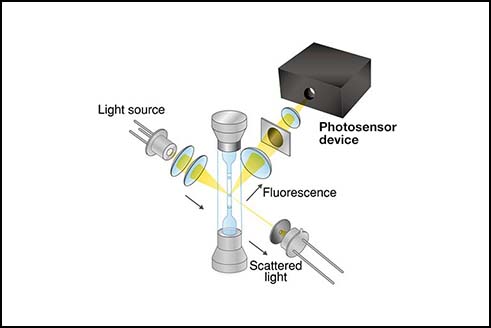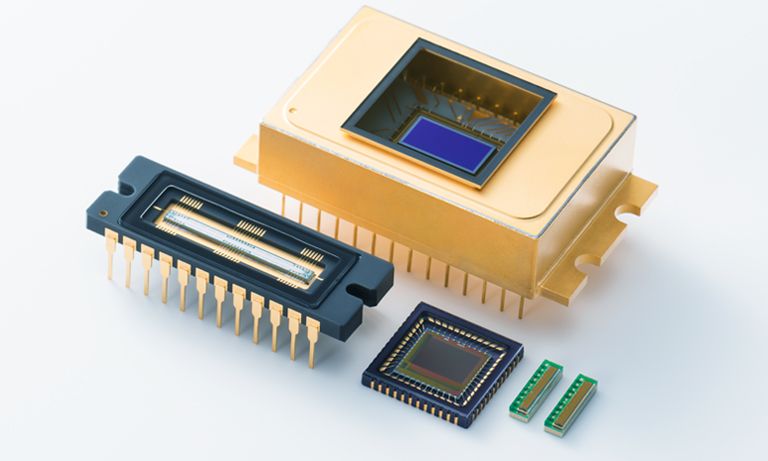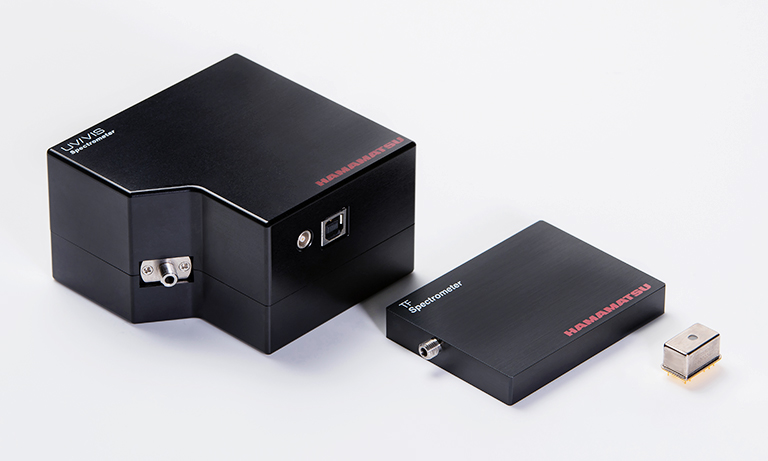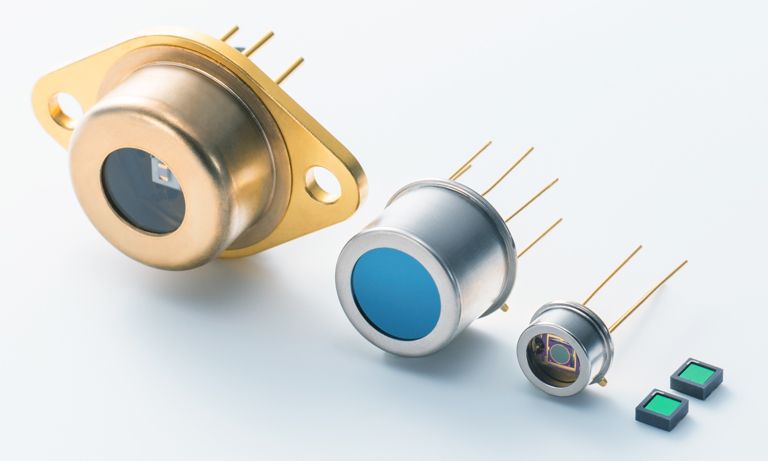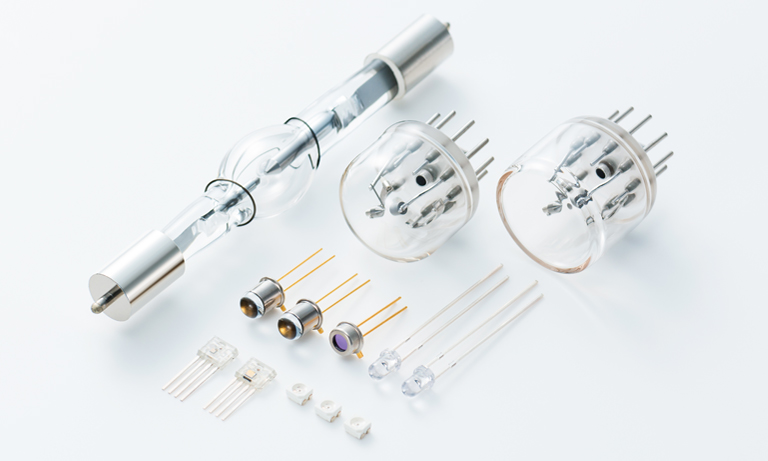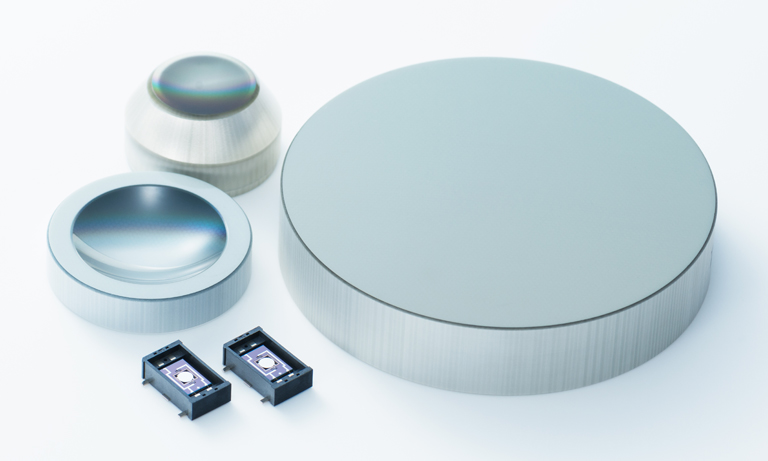Application notes
Technical notes
Ask an engineer
Publications
United States (EN)
Select your region or country.
Mid-infrared Detectors Questions & Answers
How do infrared detectors work?
There are two main classes of IR detectors: thermal and photonic detectors. Thermal detectors operate on the thermoelectric effect, where temperature is converted to an electrical voltage via a thermocouple. Essentially, there is a temperature differential within the detector that generates a voltage. Examples of thermal detectors are thermopiles, pyroelectric detectors, and bolometers. Photonic detectors on the other hand operate on the same principle as silicon photodiodes and APDs, where the photons of the IR light interact directly with the charge carriers in the detector via the photoelectric effect and generate the electrical signal that way. However, since silicon is not sensitive to MIR wavelengths, we need to use compounds such as indium arsenide antimonide (InAsSb), mercury cadmium telluride (MCT), and lead sulfide / lead selenide (PbS/PbSe). The reason we use these compounds for MIR detectors, rather than silicon, is that the band gap is smaller and is able to absorb the longer wavelengths, which allows for sensitivity to MIR wavelengths. Examples of photonic MIR detectors include InAsSb, MCT, and PbS/PbSe.
Why do we want to detect infrared light anyways?
Infrared light is ideal for detecting gases for three primary reasons.
· Sensitivity: Gases of interest have much higher absorption coefficients within the MIR spectrum, which allows us to detect them with higher sensitivity in the MIR region, from 2.5 to 14 microns.
· Selectivity: The absorption wavelengths for different gases are unique, creating a “fingerprint region” for each gas. This makes it easier to discriminate between the various gases. If we take a look at the graphic below (Fig. 1), we can see that below 2.5 micron the absorption peaks are much closer to each other, whereas above 2.5 micron (in the MIR region) the absorption peaks have less overlap, which gives us the ability to use the unique peaks to identify specific gas species.
· Water: Water has a lower absorption coefficient in the MIR spectrum; therefore, we see less of an impact on our measurement from moisture in the air, allowing for a more accurate measurement. Grey regions in the graphic below indicate which wavelengths water highly absorbs.

Figure 1. Sample of gas absorption wavelengths
Because of these factors, we are able to use IR light to measure gas concentrations very accurately using non-dispersive infrared spectroscopy, Fourier transform infrared (FTIR) spectroscopy, cavity ring-down spectroscopy, and tunable diode laser spectroscopy. These methods use an MIR source paired with an MIR detector to measure the absorption of light by gas molecules. The amount of absorption correlates to the concentration of a given gas in the environment. With these methods, we can actually achieve ppm (parts per million) sensitivity of gas concentrations or even up to ppb (parts per billion) in some cases where the IR detector has a high enough D*. To achieve ppb sensitivity, we usually need to use a cooled detector to increase the D* to the necessary level.
Optical MIR detectors can also be used for temperature sensing as heat changes the signal.
What are my options for detecting mid-infrared light optically?
MCT detectors have a relatively high D* and cutoff frequency. However, MCT crystals are difficult to grow uniformly, so there is often variation in D* across the photosensitive area of the detector, as well as from chip to chip. The difficulty of growing these crystals also makes these detectors more expensive. These detectors also require cooling, which adds size, cost, and increased power consumption to their operation, and because they contain mercury, they are not RoHS compliant. InAsSb detectors address each of these concerns, with better performance at room temperature, more consistency in D* between individual detectors, and full RoHS compliance.
Lead-based detectors, such as PbS/PbSe, have a limited cutoff wavelength (3-5 microns), so they are only suitable for certain gas species. These detectors are also slower than InAsSb detectors. Their sensitivity characteristics are highly dependent on changes in temperature, which means they require cooling for optimal performance. Because they are lead-based, these detectors are also not RoHS compliant, which is a reason that Hamamatsu does not produce this type of detector.
InAsSb detectors have many advantages. InAsSb detectors are easier to manufacture on a larger scale with consistency, so there is little variation in performance between individual detectors. Hamamatsu offers proprietary multi-stage InAsSb detectors, which are less influenced by changes in ambient temperature and allow for room temperature operation. Hamamatsu has also recently released a new back-illuminated InAsSb detector that has a further reduced photosensitivity temperature coefficient.
Type II superlattice (T2SL) detectors also consist of indium arsenide antimonide, but are manufactured using a process in which different layers with different doping concentrations are grown. This allows for increased wavelength sensitivity and excellent linearity. For applications such as long-wavelength, high-sensitivity FTIR, these detectors will require cooling for operation. While Hamamatsu currently offers only type II detectors that work with liquid nitrogen cooling, we are developing a T2SL detector with TEC cooling that should be available in 2023.
While not photonic-class detectors, thermopile detectors are also available from Hamamatsu. A thermopile is a thermal class detector that operates on the Seebeck effect. Thermopiles are slower, but are inexpensive, operate up to 20 µm, and are RoHS compliant.
If you have a technical question you’d like to see answered on this page, email us.
Meet the engineer

Matt Seeley is an Applications Engineer with a drive to share his photonics knowledge. While he originally studied mechanical engineering, Matt has since seen the light that is photonics and has found a renewed passion for engineering with photonics at Hamamatsu. When he isn’t putting around with photons, Matt enjoys playing golf and spending as much time as possible outside under the New Jersey sun.
- Confirmation
-
It looks like you're in the . If this is not your location, please select the correct region or country below.
You're headed to Hamamatsu Photonics website for US (English). If you want to view an other country's site, the optimized information will be provided by selecting options below.
In order to use this website comfortably, we use cookies. For cookie details please see our cookie policy.
- Cookie Policy
-
This website or its third-party tools use cookies, which are necessary to its functioning and required to achieve the purposes illustrated in this cookie policy. By closing the cookie warning banner, scrolling the page, clicking a link or continuing to browse otherwise, you agree to the use of cookies.
Hamamatsu uses cookies in order to enhance your experience on our website and ensure that our website functions.
You can visit this page at any time to learn more about cookies, get the most up to date information on how we use cookies and manage your cookie settings. We will not use cookies for any purpose other than the ones stated, but please note that we reserve the right to update our cookies.
1. What are cookies?
For modern websites to work according to visitor’s expectations, they need to collect certain basic information about visitors. To do this, a site will create small text files which are placed on visitor’s devices (computer or mobile) - these files are known as cookies when you access a website. Cookies are used in order to make websites function and work efficiently. Cookies are uniquely assigned to each visitor and can only be read by a web server in the domain that issued the cookie to the visitor. Cookies cannot be used to run programs or deliver viruses to a visitor’s device.
Cookies do various jobs which make the visitor’s experience of the internet much smoother and more interactive. For instance, cookies are used to remember the visitor’s preferences on sites they visit often, to remember language preference and to help navigate between pages more efficiently. Much, though not all, of the data collected is anonymous, though some of it is designed to detect browsing patterns and approximate geographical location to improve the visitor experience.
Certain type of cookies may require the data subject’s consent before storing them on the computer.
2. What are the different types of cookies?
This website uses two types of cookies:
- First party cookies. For our website, the first party cookies are controlled and maintained by Hamamatsu. No other parties have access to these cookies.
- Third party cookies. These cookies are implemented by organizations outside Hamamatsu. We do not have access to the data in these cookies, but we use these cookies to improve the overall website experience.
3. How do we use cookies?
This website uses cookies for following purposes:
- Certain cookies are necessary for our website to function. These are strictly necessary cookies and are required to enable website access, support navigation or provide relevant content. These cookies direct you to the correct region or country, and support security and ecommerce. Strictly necessary cookies also enforce your privacy preferences. Without these strictly necessary cookies, much of our website will not function.
- Analytics cookies are used to track website usage. This data enables us to improve our website usability, performance and website administration. In our analytics cookies, we do not store any personal identifying information.
- Functionality cookies. These are used to recognize you when you return to our website. This enables us to personalize our content for you, greet you by name and remember your preferences (for example, your choice of language or region).
- These cookies record your visit to our website, the pages you have visited and the links you have followed. We will use this information to make our website and the advertising displayed on it more relevant to your interests. We may also share this information with third parties for this purpose.
Cookies help us help you. Through the use of cookies, we learn what is important to our visitors and we develop and enhance website content and functionality to support your experience. Much of our website can be accessed if cookies are disabled, however certain website functions may not work. And, we believe your current and future visits will be enhanced if cookies are enabled.
4. Which cookies do we use?
There are two ways to manage cookie preferences.
- You can set your cookie preferences on your device or in your browser.
- You can set your cookie preferences at the website level.
If you don’t want to receive cookies, you can modify your browser so that it notifies you when cookies are sent to it or you can refuse cookies altogether. You can also delete cookies that have already been set.
If you wish to restrict or block web browser cookies which are set on your device then you can do this through your browser settings; the Help function within your browser should tell you how. Alternatively, you may wish to visit www.aboutcookies.org, which contains comprehensive information on how to do this on a wide variety of desktop browsers.
5. What are Internet tags and how do we use them with cookies?
Occasionally, we may use internet tags (also known as action tags, single-pixel GIFs, clear GIFs, invisible GIFs and 1-by-1 GIFs) at this site and may deploy these tags/cookies through a third-party advertising partner or a web analytical service partner which may be located and store the respective information (including your IP-address) in a foreign country. These tags/cookies are placed on both online advertisements that bring users to this site and on different pages of this site. We use this technology to measure the visitors' responses to our sites and the effectiveness of our advertising campaigns (including how many times a page is opened and which information is consulted) as well as to evaluate your use of this website. The third-party partner or the web analytical service partner may be able to collect data about visitors to our and other sites because of these internet tags/cookies, may compose reports regarding the website’s activity for us and may provide further services which are related to the use of the website and the internet. They may provide such information to other parties if there is a legal requirement that they do so, or if they hire the other parties to process information on their behalf.
If you would like more information about web tags and cookies associated with on-line advertising or to opt-out of third-party collection of this information, please visit the Network Advertising Initiative website http://www.networkadvertising.org.
6. Analytics and Advertisement Cookies
We use third-party cookies (such as Google Analytics) to track visitors on our website, to get reports about how visitors use the website and to inform, optimize and serve ads based on someone's past visits to our website.
You may opt-out of Google Analytics cookies by the websites provided by Google:
https://tools.google.com/dlpage/gaoptout?hl=en
As provided in this Privacy Policy (Article 5), you can learn more about opt-out cookies by the website provided by Network Advertising Initiative:
http://www.networkadvertising.org
We inform you that in such case you will not be able to wholly use all functions of our website.
Close


